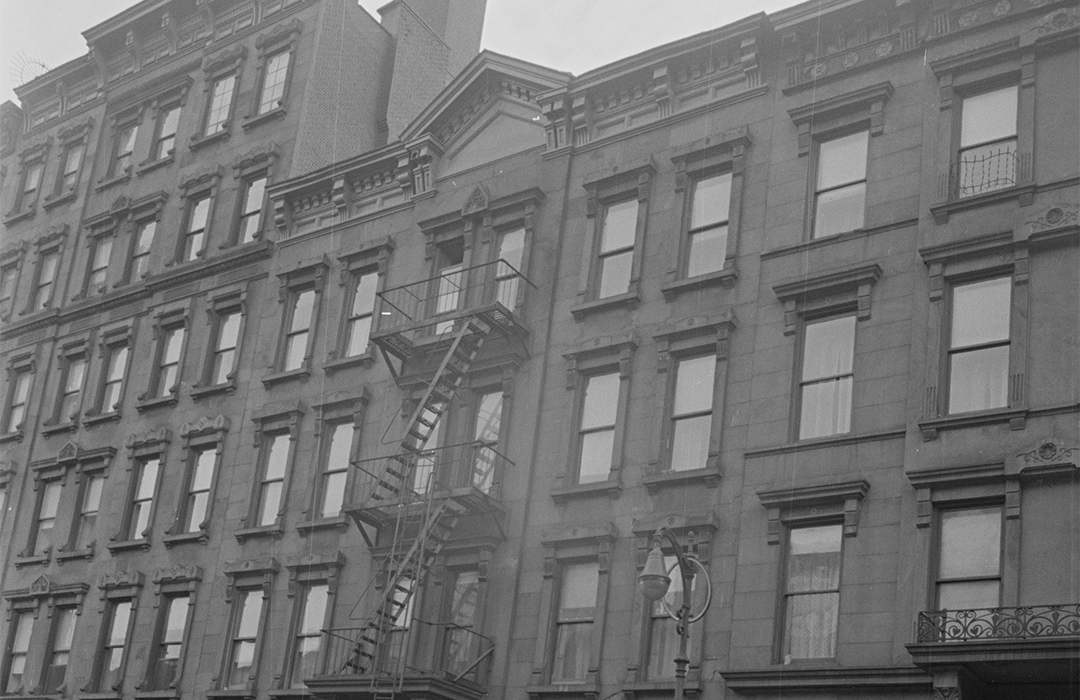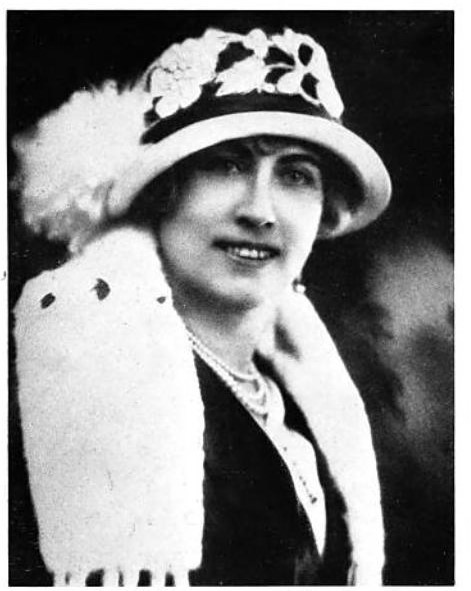
108 West 61st Street
by Tom Miller
In 1881 developer John Moloy hired the architectural firm of A. B. Ogden & Sons to design several flat buildings along the block of West 61st Street, between Ninth and Tenth Avenues. Among them was 108 West 61st Street, the plans for which were filed on July 1. The “four-story brown stone tenement” would cost Moloy $30,000 to construct, or just over $885,000 by 2024 conversion. A. B. Ogden & Sons dipped into a grab bag of historical styles. The windows were given defined neo-Grec frames with prominent bracketed cornices. The terminal cornice with its peaked parapet smacked of the city’s Italianate schoolhouses of a generation earlier. And, above a five-step stoop, the entrance portico was upheld by polished granite columns that drew from the Romanesque Revival style.
Although technically within the San Juan Hill neighborhood, known for its ethnic diversity and, too often, poverty and crime, 108 West 61st Street was on its eastern edge, and so somewhat removed. Therefore, unlike many other San Juan Hill residents, its occupants were financially comfortable.
As a matter of fact, some, like Mrs. W. Jackson, focused on helping the less fortunate. On December 3, 1887, the New York Herald reported that she was involved in the organization of “a medical air society” to address “the lack of dispensaries in the poorer sections of the city.” She told a reporter that to maintain the dignity of the clients, the dispensaries “will not be conducted on a charitable basis, but anyone can become a member and entitled to medical attendance for himself and his family on payment of fifty cents admission fee and ten cents weekly. This includes whatever medicine may be necessary. A member who may require the attendance of a doctor at his house will only be charged twenty-five cents a visit,” she said, adding, “This plan, you see, makes it easy for the proudest and most independent person to come to us for aid.”
Living here at the time was Dr. John Wheeler Leavitt. A contributor to the Encyclopedia Britannica, he had written the book Exercise a Medicine in 1870. The General Catalogue of the Psi Upsilon Fraternity mentioned in 1888 that he had been “practicing the Magnetic Treatment since 1877.”
With just two apartments per floor, there was enough room for some tenants to have live-in help. An advertisement in The World on September 6, 1890, read:
Cook—A good, settled colored woman; must be a good cook and do general housework in a small family of two only; if party suits, permanent home. Apply at once 108 West 61st st., 1st floor.
Slocum suffered what newspapers would have politely termed “reversals.”
The middle-class status of the residents was evidenced in Gustavus Jewell’s new job in July 1891. Called by The Sun “an expert accountant,” he was appointed auditor of the Board of Fire Commissioners with a salary of $3,000, just under $100,000 by today’s terms.
Gusatavus’s wife was the former Melinda Slocum. Her brother, Sidney Slocum, was described by The New York Times in 1898 as “once well known in connection with the canal boat business.” That year, Slocum suffered what newspapers would have politely termed “reversals.” His wife, according to the Jewells’ daughter, “had deserted him some years ago” to live with a man in Washington, D.C. After that man died, she returned to Brooklyn and to Sidney Slocum. On June 15, 1898, The New York Times reported, “His niece, Miss Jewell, said that he had been turned out of doors recently by his former wife.”
Sidney came to 108 West 61st Street to live temporarily with the Jewells. On June 3, 1898, he went downtown where, according to The New York Times, “he was seized with a sudden attack of illness, which led him to take a room in a South Street lodging house for the night.” The following morning, he was so sick that he was taken to the Hudson Street Hospital. He died on June 13 at the age of 65 of what was diagnosed as Bright’s Disease. The man who had once been successful and affluent “was utterly penniless,” according to the article.
Bicycles in the 1890s were a popular fad and an expensive one. Resident Mrs. William Lennox owned a bicycle and joined a host of other Upper West Side residents who signed a petition in August 1895 urging the Board of Aldermen to consider “the necessity for the bicycle path between the upper and lower parts of the city.”
At the turn of the century, a man named Roberts was the superintendent of the building. His family occupied one of the second-story apartments. Every evening, he would take a walk around the neighborhood. On August 13, 1900, The New York Times reported that the Roberts’ ten-year-old daughter, Madeline, “leaned far out of the second-story window at the hour when her father usually enters the house after his evening stroll.” In a horrific turn of events, “As she watched for her father’s coming, her pet dog Bonnie jumped on her shoulder so suddenly that she lost her balance and fell to the street.” Thankfully, the girl was not killed, although she suffered a broken jaw and was taken to Roosevelt Hospital for treatment.
Persons hiring servants always insisted on references. One reason was what police termed “the servant game.” Young girls would take jobs as maids, then leave in a day or so with valuables taken from the home. On December 27, 1903, The Sun reported that three thieves had been arrested with nearly $10,000 worth of stolen property in their room. “Two of the prisoners are negro women who have worked as servants in well to do families and who, the detectives say, have robbed their employers.” One of the accused was Frances Williams, who had worked for a series of women, including “Mrs. Furr of 108 West Sixty-first street.” The valuables were taken to Police Headquarters, and the victims notified. “Mrs. Furr laid claim to some bed linen, dishes and silver,” said the article.
At the time, George E. and Bertha Folz owned and lived in the building. Among their tenants were the Nelson Riger family, who were related to the Folzes. In 1906, the neighborhood was being terrorized by an arsonist who, on November 9, set three more fires, one in the building next door to 108 West 61st Street. As the blaze took hold, Henry Riger ran to the street, “and the first person he met was [Frank] Morris,” reported The New York Times. Riger’s description led to the youthful arsonist’s arrest.
That same year, George A. Riger passed the civil service test to be a financial clerk with the city, and on April 19, 1907, The Morning Call of Paterson, New Jersey, reported on the “pretty wedding at St. Paul’s Church” in that city. Lillian Hartmeier had married Joseph A. Riger. Among the bridesmaids were Joseph’s sister, Katherine Riger, and John Folz served as one of the ushers. Of course, George and Bertha Folz were among the guests at what the newspaper called a “brilliant reception.” (Incidentally, the Folzes had sold 108 West 61st Street a year earlier.)
Mrs. John Finn lived here on February 3, 1909, when she and a friend, Julia McCarthy, headed to the Paulist Church at 59th Street. As they approached the church, they noticed a woman hurry up the steps with a package and then quickly retreat down the stairs without it. The Evening World reported, “As soon as they got inside, they heard a child cry and told Policeman Cavanaugh, and he overtook the other woman. The three women with the policeman went back to the church.” In the vestibule, they found a brown paper package that held a two-day-old baby boy. On his clothing was pinned a note, “Please have this boy baptized a Catholic. Call him John Bynne. God bless and God forgive all connected with this. If possible have him sent to a Catholic institution.”
In 1906, the neighborhood was being terrorized by an arsonist
The 55-year-old woman, Ellen Murphy, was arrested. She told the judge a heart-breaking story:
Judge, I did this to save somebody I love from an everlasting disgrace. I didn’t mean to do away with the baby. As God lives, I meant he should be cared for. But I can’t say another word if I go to prison for the rest of my life. I can stand the shame better than anyone else.
A detective investigated and discovered Ellen Murphy’s story was true. The mother was a 19-year-old girl who was in critical condition at her father’s house after the childbirth. The New York Times reported, “Magistrate Kenochan decided not to issue a warrant for the girl or to bring her into the case.”
Interestingly, resident John A. Lee was the chief plan examiner in the city’s Tenement-House Department. Born in 1854, he first became an inspector in the Board of Health and was appointed to his present position in 1902. He died in May 1909 at the age of 55. The family was still living here in 1911 when his son, John A. Lee Jr., became a director in the Fibrex Sales Co.
The Schroetter family moved into the building in 1918. Mrs. Schroetter was known professionally as concert singer Anna van Gerow, who had studied singing in Europe. On October 10, 1918, Musical Courier reported, “Anna van Gerow (Mrs. Schroetter) has issued cards containing a likeness of herself. She has sung much in concert, church, and opera, and has recently moved to the metropolitan, 108 West Sixty-first street, New York. The Schroetter’s adult daughter, Helen, became a commissioner of deeds that year, a position similar to a notary public.
The Schroetters remained in 108 West 61st Street into the 1920s, however by 1927 it appears that Anna had separated from her husband. An article in the March issue of The Forecast profiled Anna van Gerow, “who occupies the unique position of ship’s hostess for a large steamship company.” No mention was made of any other family members.
As mid-century approached, Victorian flat buildings like this one were out of fashion. In 1940, the renters of almost every apartment took in lodgers (unlike boarders, lodgers received no meals or amenities other than a bed). That year, for instance, Mary Smith had four lodgers, three American and one English; Jane Flynn’s lodgers were from “Eire” or Ireland, Lithuania, Yugoslavia, the United States, and Brazil; and Mary Corrigan, an immigrant from Ireland, had four lodgers from her home country.
B. Ogden & Sons’ handsome brownstone flat building was razed in 1985 to make way for the Fordham University Campus. Even the street upon which the building stood was erased.
Tom Miller is a social historian and blogger at daytoninmanhattan.blogspot.com



